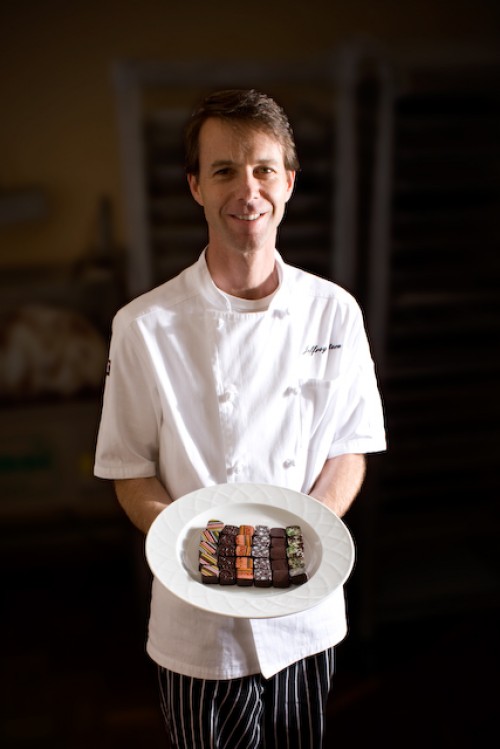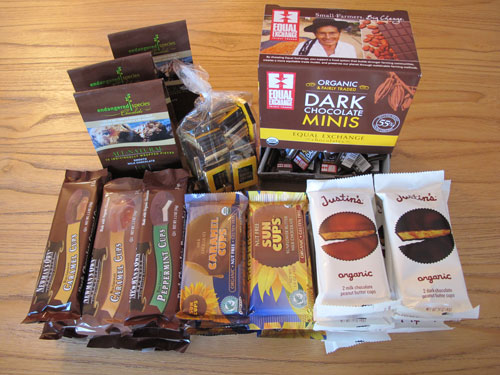Ethical Halloween Candy 2011 Taste Test Results

Trick or Treat! by Jason Paluck
A few weeks ago, I posted a long list of ethical Halloween chocolate candy alternatives. Because these alternative candies are unfamiliar to many, I sent samples out to a small army of kid and adult taste testers to ask their opinions. My goals were to get a sense for how kids and adults react to candy that is new and different and to see if they would even like these lesser known ethical alternatives.
In short, there’s good news. Our tasters ranked several fairly traded alternative candies superior to traditionally popular brands lacking ethical sourcing. Some concerns were raised about availability, package design, candy size, and price points, but the results of this taste test were largely successful.
The totally-unscientific-yet-super-delicious survey design went something like this:
I sent the survey out to 8 families, 24 people total. Each family received 5-6 types of candy to try. I asked each person in the family to rate each candy as “Yummy,” “OK,” or “Gross.” I also included a few questions:
- “How does this candy compare to other peanut butter cups/milk chocolate squares/peppermint patties that you’ve had?”
- “Do you like the packaging?”
- “Is the candy too big or too small for Halloween?”
- “What is your favorite candy that you tried today?”
- “What is your favorite candy in the whole world?”
Kids included in the survey ranged in age from 2 to 10. I sent it to kids who can’t get enough sugar, kids who would choose a chicken drumstick over a candy bar any day, kids who don’t like chocolate, kids who eat mostly pickles, and kids who can’t stand peanut butter. Adults ranged from 25 to, well, let’s say over 50. (*wink*) The adults were a mix of the candy apathetic and self professed chocoholics, some firmly in the milk chocolate camp and others insisting that only dark can satisfy their needs.
Here’s what we learned.
On the plus side:
- Unsurprisingly, everyone was excited to try this candy. One survey respondent, upon learning that the candy was en route, wrote: “Nom nom nom. Excitement building.”
- The simple act of participating in this survey got people talking about ethical chocolate in a way that they hadn’t before. Several parents commented on their children’s shocked reactions to the problem of forced, trafficked, and child labor in West Africa. One proud father wrote: “We absolutely tried ALL the chocolates — loved most of it…. AND we are buying ETHICAL Halloween candy this weekend from Whole Foods!!” Another parent explained that his six year old daughter felt so strongly about the issue that she took it upon herself to organize the family’s tasting and to tell all of her friends at school to look for fair trade candy from now on.
- Every family reported back that this was a fun exercise in taste, marketing, and ethics to enjoy as a group. “It really gets you thinking about the chocolate that we buy out of habit and what other chocolate we might just pass by,” explained one participant. One family even suggested that their kids, while typically reluctant to try new things, were excited enough about the tasting event that they happily ripped into everything with gusto.
- We also found candies that survey respondents preferred to their Hershey’s counterparts. Yum! More on the favorites below.
However, there were some challenges:
- Both kids and adults reported difficulty in comparing the taste of ethical candy alternatives to better known traditional candies. A mother of two wrote that, while often delicious, the candies were just plain different: “It is difficult to rate the candy because unfortunately we compare it to well know commercially sold candy that has been around forever.”
- Several adult survey respondents were concerned about price. “We sometimes have over 100 trick-or-treaters,” one participant told me, “so we have to keep costs as low as possible.”
- Several kids reported back that they didn’t find the packaging for the ethical candies to be very fun. A ten year old respondent and his mother said that some of the candy packaging “could use a facelift.” Another parent described the majority of the candy packaging as “boring and unappealing.”
- There were negative taste ratings on certain candies. Taste is an individual, subjective affair, and one product can’t please everyone all of the time. In addition, it goes to show that even when candy is ethically sourced, quality production and excellent taste are not a guarantee. More on the taste disappointments follows.
The absolute favorite candies were, in order of popularity:
- Justin’s Nut Butter Peanut Butter Cups: Several survey respondents ranked these among “the best peanut butter cups” they had ever had, and all but a few rated them significantly higher than Reese’s peanut butter cups. Parents wished that the candies were available in single servings as opposed to doubles.
- Equal Exchange 55% minis: Almost all survey respondents absolutely loved these; only a few of the kids found the chocolate to be “a bit bitter.” One young lady carefully practiced her newly mastered penmanship, writing “The Equal Exchange is awesome.” The adult tasters said that they enjoyed the complexity of chocolate, even identifying flavors of “cinnamon, caramel, and other spices.” Most kids said that these candies were too small, while most adults said that they were perfectly sized for trick-or-treaters. Go figure.
- Endangered Species Milk Chocolate Halloween Treats: These candies were widely popular among both kids and adults, with many people remarking that they found them “not too sweet,” and “refreshingly less sweet than Hershey’s.” The packaging, however, did not appeal to many.
- Newman’s Own Organics Peanut Butter Cups: These peanut butter cups came in at a close second to Justin’s and were a big crowd pleaser. Most parents agreed that they would prefer to buy these candies as singles, rather than in the usual package with three cups.
Among almost all adults and a few adventurous kids, the Michel Cluizel, Pralus, and Askinosie were extremely popular. Several of the adults, having tried these brands for the first time, said that they would seek them out in the future, intending to have them on hand for when they “need a serious chocolate fix.” One mother described the Cluizel as “some of the most complex chocolate I have ever had.” Another survey participant could not wait to try more of the single origin bars from Pralus and Askinosie. These three brands, while perhaps not widely known at a major commercial level, are from well respected high quality chocolate makers, so this does not come as a surprise.
The Newman’s Own Organics Peppermint Cups and Caramel Cups and Sun Cups Caramel and Sunflower Chocolate Cups were all well liked by more than half of the survey respondents, but were subject to individual taste preferences. For example, some participants do not like peppermint or caramel with chocolate. Those who liked them shared the refrain “We want more!” Others said that they enjoyed the Sun Cups Sunflower Chocolate Cups, but that, because they have the option, they prefer to eat peanut butter cups instead.
Some candies were ranked as needing improvement:
- Sun Cups Mint Chocolate Cups: Most survey respondents described these candies as too sweet and found the peppermint oil flavor too strong. The chocolate was criticized for being grainy, with a poor texture.
- Divine 70% Dark Chocolate Bites: Most survey respondents found the chocolate flavor in these bars to be too intense, with a long and somewhat unpleasant aftertaste. They also described the texture as “too waxy.”
(Note: We didn’t get to try all of the candies on the list due to time and budget constraints. I can say from personal experience, though, that I have previously enjoyed Sjaak’s, Chuao Chocolatier, and Sweet Riot’s tasty treats. They certainly merit further exploration in chocolate tasting adventures.)
All in all, this was a fun and educational exercise. Thanks so much to the wonderful survey participants — to the wicked awesome kids who so graciously suffered through the eating of ridiculous amounts of candy to help me out, and to the kind, patient parents who supervised the filling out of the surveys and the resulting sugar highs. You’re the best!
Update (October 31, 2011): Visit The Root to read more of my thoughts on this topic: Chocolate’s Bittersweet Legacy.
Happy Halloween!
Interview with Jeffrey Stern, chocolatier and chocolate advocate in Quito, Ecuador
Jeffrey Stern is a chocolatier, chocolate advocate, entrepreneur, and blogger based in Quito, Ecuador. I recently asked Jeff to answer a long list of questions about his life and work, and he was kind enough to oblige. Below, in the first half of this interview, Jeff details the missions of his companies and his educational and work background (which, I should note, left him singularly well prepared for his current work). He also explains many of the challenges that small batch production chocolatiers face in relation to direct trade, marketing, and domestic/international bureaucracy, as well as the travel and learning opportunities that forever changed the way he tastes and understands chocolate.

Photo courtesy of Jeffrey Stern
Interview with Jeffrey Stern, Part 1, October 2011
Carla Martin (CDM): What is the focus of your two companies, and what are their missions?
Jeffrey Stern (JS): The focus of my Ecuador based company, Gianduja Chocolate, is to provide high quality, sophisticated bonbons and chocolate products for the local market, using almost all local ingredients. I use only Ecuadorian chocolate, local fruits, cream, and butter, and the only imported items I use are those not available here like transfer sheets, real vanilla, and colored cocoa butters.
My other company, Aequare Fine Chocolates, had as its original mission the goal of importing, wholesaling, and retailing to the United States fine chocolates made in Ecuador with top quality Ecuadorian chocolate. Also, I made it a point of this company to have contact with and knowledge of the chocolate and its origins from bean to final product. I knew the grower of the beans and how he managed his farm, I knew the factory and operations where the chocolate was made, and of course I made the final chocolates myself. We imported into the United States and retailed through the website and worked with a few brokers. Ultimately, the idea was to add value to cacao in the country of origin, and have direct trade relationships with all our suppliers here in Ecuador.
Unfortunately, I think the story was somehow not compelling enough for consumers and what I envisioned as an artisan product being made in Ecuador simply ended up being perceived as another consumer packaged good once it was in the US. Sort of a “lost in translation” problem, as well as the difficulty of explaining a “direct trade” story when you don’t have a multimillion dollar marketing campaign behind the product(s), a big PR budget, etc.
Also, the lack of any US physical presence and someone who could do tastings and trade shows made it difficult to get the product exposure. I think if I had had a physical location somewhere that would have helped a lot. Finally, I see the whole marketing system in the US as such a giant machine, with brokers, distributors, etc. It’s really hard to get your product recognized and noticed, as well as costly if you want to do trade shows. Because the US market and system is so massive, I see it as causing an unfortunate disadvantage for the consumer who, despite the increasing growth and interest in artisan and handmade foods, remains highly disconnected from foods’ origins. And with chocolate, coming all the way from a far off country, it’s even harder to establish and tell a compelling story that offers the authenticity and traceability that consumers often want.
CDM: What are the primary activities of your chocolate and cacao education and training services?
JS: Primarily, I work with companies outside of Ecuador who usually know nothing about the country or the cocoa trade, and want to source either cacao from Ecuador or a semi-processed product such as cacao liquor or powder, or want to have a cacao-based product contract manufactured in Ecuador. I have also worked with artisan bean to bar companies who are looking to source cacao beans from Ecuador. Finally, I act as a “chocolate expert” for chocolate tours — these can be either groups who just have a casual interest in chocolate, or professional groups. I am currently working with three tour operators in Ecuador offering 3-5 day tours centered around chocolate activities, including visits to artisan chocolate makers, visits to plantations, fermentation and drying centers, brokers, and chocolate tastings. I have also been hired to work as a chocolate expert for a well known online chocolate school which will be offering a professional tour in June of next year for chocolatiers and bean to bar chocolate makers.
CDM: How were your companies started?
JS: I moved to Ecuador with my wife and family in May of 2007, with the intention of opening my chocolate business. I had lived in Ecuador from 1994 to 1995, first while getting my Master’s in Community and Regional Planning, and then returned to work for USAID after graduating. I then traveled to Ecuador almost annually until 2007. I got the idea of starting the chocolate business several years after I changed careers (2001, when I attended culinary school). We did some test marketing in trips to Ecuador in 2005 and 2006, and found there was a good market for chocolate. I founded my other company, Aequare, in 2008, with the intention of exporting chocolates from Ecuador. After our first year here, I realized the market wasn’t as big as I had initially expected, and decided to export.
CDM: How are your companies structured, and how many employees work with the companies?
JS: Our local company in Ecuador, Gianduja Chocolate, is a sole proprietorship. I am the chocolatier, my wife takes care of administration and accounting, and I have one employee who knows about 80% of what I do. My other company is an LLC. I am the only employee. When the need arises, I occasionally hire an additional person, but due to very onerous labor laws in Ecuador which make part-time or hourly payment nearly impossible, it’s rare.
CDM: What is your educational background and training?
JS: I have a Bachelor’s in Latin American Studies from New York University and a Master’s Degree in Community and Regional Planning from the University of Texas at Austin. I am also a 2001 graduate of L’Academie de Cuisine in Gaithersburg, Maryland, where I earned a degree in culinary arts.
CDM: What type of work were you involved in before beginning these companies? Was it related to or unrelated to chocolate?
JS: My first career after college and graduate school was primarily in foreign aid; specifically, I spent several years working with USAID based in Ecuador. I also worked with a consulting firm in Washington, DC for one year that was focused primarily on World Bank, Inter-American Development Bank, and USAID projects. I spent two years in Nicaragua working in population and health programs with USAID as well. None of the work was related to chocolate.
After completing my culinary training, I worked in restaurants, catering operations, and as a personal chef. I later worked in a chocolate shop part-time.
CDM: What are some of the challenges that you have encountered while running your businesses?
JS: Ecuador’s environment, both on the private sector side and the public (government) side is all about friction. There seems to be a genuine lack of cooperation — it sounds amusing, but it’s not.
While getting permits and paperwork for operating has gotten a little bit more transparent in recent years, things still seem very arbitrary and ambiguous. It used to be that you had to hire an “expediter” to get almost anything done — that’s doublespeak for someone who you pay to grease the wheels of bureaucracy and issue you permits in a timely fashion. Now you can get many permits directly yourself, but the amount of time and money involved makes it just as costly as if you had hired the expediter.
When you go to an agency, be it the Municipality, the tax agency, the Ministry of Health, you can get one answer one day, and the next day you go back with the same question, and you’ll get an entirely different answer. You get the feeling that nobody really knows the rules, and that they’re being made up as things move along. So you never are really sure if you’re doing things right. It’s very frustrating and unnerving.
On the private sector side, there are difficulties in getting paid. No one uses the mail here, and messenger services only occasionally. Electronic payments are the exception, not the rule. Most companies pay from 2pm-4pm on Friday afternoons at their offices. So if you can’t make it to pick up your check, you have to wait another week to get paid. Fortunately, I have enough business now and a unique product that allows me to have a “cash only — take it or leave it” policy. That is, if you want the product, it’s cash or check on delivery, with few exceptions only for longstanding clients.
There’s very little collaboration or cooperation among similar types of businesses to help each other out. For example, there is no organization or association in Quito of chocolate makers who might attempt to work together for publicity or other ends to grow the market cooperatively for their products. Businesses jealously guard their secrets. I call this an economy of scarcity, not abundance, and thus, because even information is scarce, no one shares it. I think in the long run it’s detrimental to business, and while this is a broad generalization, I think the lack of trust and cooperation is one of the factors that hinders economic growth.
CDM: How do you keep up to date with new developments in chocolate?
JS: I mostly use the web to learn about what is going on in the chocolate world. Here in Ecuador, I have regular contact with people in the cacao and chocolate industry from growers to manufacturers of chocolate and semi-processed products such as liquor and powder. We have recently formed a group of professsional industry people involved in chocolate at all points in the supply chain called the “Academia de Chocolate,” which is another forum for sharing and gathering information.
CDM: Why chocolate? What about it is fascinating to you?
JS: I got interested in chocolate when I started working part-time in a chocolate shop. I hadn’t really gotten a good understanding of how to work with chocolate in culinary school, so I got some books and started to study on my own. There are very few sources that clearly explain what tempering chocolate actually is; when I was finally able to read about the polymorphism of cocoa butter and how temperature affects crystal formation in chocolate, I was able to wrap my head around it. Not only does chocolate taste good, of course, but it’s a fascinating substance to work with.
After almost 5 years in Ecuador in the chocolate business, my knowledge has expanded far beyond just the technical know-how of chocolate making. I have knowledge of bean to bar operations, identifying quality cacao, import/export operations, and how the cacao industry works in Ecuador.
CDM: What was your “aha” moment in relation to chocolate?
JS: I never really understood what chocolate was and how its flavor was developed until I actually went to a plantation and tasted several chocolate liquors (pastes) made on the spot from beans. When I tasted various liquors side by side from beans from different areas, with different fermentation, I suddenly realized just how important the beans are and just how different beans with different fermentations, roasts, etc can be. It was like a light bulb went on in my head — a total epiphany. Now when I taste chocolate I have a much better picture in my head (or taste map, however you’d call it) of what’s good or off about a chocolate’s flavor than I ever did before.
——————————————————————————————————————————–
Visit Jeffrey Stern’s blog here to learn more about his adventures with chocolate just south of the equator, and follow his company Gianduja Chocolate on his website and on Facebook. Also, stay tuned for Part 2 of this interview, as well as details on Jeff’s upcoming Kickstarter campaign — he is currently working to launch a direct trade project to promote Ecuador’s heritage Nacional cacao and benefit small farmers.
Update (November 8, 2011): Part 2 of the interview can be read here.
Ethical Halloween Candy 2011

Halloween Controversy by mtsofan
Halloween is one of the biggest chocolate candy holidays of the year, with over 100 million dollars in sales. Unfortunately, the vast majority of chocolate candy sold for Halloween is made from cacao that is grown under dubious labor conditions. (According to the International Cocoa Organization, only 0.1% of chocolate sold is fair trade certified.)The problems of forced, trafficked, and child labor on cacao plantations have been documented throughout West Africa, the region that produces nearly 70% of the world’s cacao for chocolate that will be consumed abroad, mostly in North America and Europe (see here and here for an introduction). One of the worst offenders in the chocolate industry’s snail’s pace response to these issues is Hershey’s, which consistently receives a failing grade on forced, trafficked, and child labor and has taken no action toward instituting verified third party systems to investigate and prevent labor abuses.
Read the 2011 report Still Time To Raise the Bar: Real Corporate Social Responsibility (PDF) for full details on Hershey’s stark underachievement in tracing its supply chain and preventing labor abuses in its cacao cultivation. The report, produced and edited by Global Exchange, Green America, and The International Labor Rights Forum, documents the company’s inaction and lack of transparency on the problem, showing that it lags behind every other major chocolate producer in meeting the standards set in the Harkins-Engel Protocol of 2001 (PDF), an international agreement aimed at ending the worst forms of child labor in the cocoa industry.
This Halloween, Hershey’s, which commands the largest single share of the US chocolate market (42.5%), stands to make over 50 million dollars in chocolate candy sales. Given the company’s long time complacency in the face of unacceptable labor practices, many consumers are consciously choosing not to purchase Hershey’s products for the trick-or-treaters who will knock on their doors. This post marks an attempt at providing better alternatives.
The criteria for inclusion on this list of alternatives follow, based on market research into Halloween chocolate candy sales and the added requirement for transparency into labor practices:
- Low prices are key to successful sales of Halloween candy. The candy listed below is affordable for a range of price points, from cents to a couple of dollars per piece.
- Candy must be small in portion size and individually wrapped. It must also be available in retail stores or for purchase online in bulk quantities (this excludes many craft chocolate and confectionery makers that do not typically provide products in this way). Most consumers of Halloween chocolate candy buy it at the nearest supercenter or warehouse club, so accessibility is key.
- Halloween candy must be child friendly in taste and appearance, or one might wake up to a yard full of rotten eggs and toilet paper. It has been my experience that young tastebuds are generally happiest in the 30-55% cacao content range. I’ve included some higher cacao content options for dark chocolate loving palettes. You don’t have to take my word on taste, as I’m sending out samples of these chocolates to a small army of kid and adult taste testers and will summarize their reviews in upcoming posts. Happy early Halloween, y’all!
- The candy on this list must be third party fair trade certified or be fairly traded, with transparent, well documented labor practices.
Without further ado, the list:
Ethical Halloween Candy 2011: offering tasty and affordable alternatives to Hershey’s products
Alternatives to Hershey’s Reese’s Peanut Butter Cups
- Sjaak’s Halloween Peanut Butter Bites
Price: 35-43 cents per piece ($9.95 for a 6 oz bag or $33.00 for a 1.5lb tub, about 93 pieces)
Where to buy: Online
Ethics: Fair Trade USA and USDA Organic Certified - Justin’s Nut Butter Peanut Butter Cups (with milk or dark chocolate)
Price: $1.50-$1.59 per package (of 2 cups)
Where to buy: Online or Find a store
Ethics: Rainforest Alliance Certified chocolate and USDA Organic Certified ingredients - Newman’s Own Organics Peanut Butter Cups (with milk or dark chocolate)
Price: $1.50-$1.80 per package (of 3 cups)
Where to buy: Online or Find a store
Ethics: Rainforest Alliance Certified
Alternatives to Hershey’s York Peppermint Patties
- Newman’s Own Organics Peppermint Cups (dark chocolate)
Price: $1.50-$1.80 per package (of 3 cups)
Where to buy: Online or Find a store
Ethics: Rainforest Alliance Certified - Sun Cups Mint Chocolate Cups
Price: $1.90-$1.99 per package (of 2 cups; $1.99 for a package or $37.99 for variety pack of 20 packages)
Where to buy: Online or Find a Store
Ethics: Rainforest Alliance Certified and USDA Organic Certified
Alternatives to Hershey’s Rolo Caramels
- Newman’s Own Organics Caramel Cups (milk or dark chocolate)
Price: $1.50-$1.80 per package (of 3 cups)
Where to buy: Online or Find a store
Ethics: Rainforest Alliance Certified and USDA Organic Certified - Sun Cups Caramel Chocolate Cups
Price: $1.90-$1.99 per package (of 2 cups; $1.99 for a package or $37.99 for variety pack of 20 packages)
Where to buy: Online or Find a Store
Ethics: Rainforest Alliance Certified and USDA Organic Certified
Alternatives to Hershey’s Miniatures Milk Chocolate and Special Dark
- El Rey Chocolate squares in 58.5%, 61%, 70%, or 73.5% cacao content
Price: 13-25 cents per square ($6.95 for 28 squares or $25.00 for 200 squares)
Where to buy: Online or Find a store
Ethics: Well documented history of fair trade practices. - Equal Exchange Dark Chocolate (55%) Minis
Price: 17-20 cents per mini ($29.75 for approximately 150 minis, or $148.75 for 888)
Where to buy: Online
Ethics: IMO – Fair for Life Certified and USDA Organic Certified - Divine 70% Dark Chocolate Bites
Price: 27-30 cents per piece ($14.99 for 1/2 lb, approximately 50 pieces, or $54.88 for 200 pieces)
Where to buy: Online
Ethics: Fair trade purchasing structure and partially farmer owned company. - Endangered Species Milk or Dark Chocolate Halloween Treats or Bug Bites
Price: 28-29 cents per Halloween Treat and 53 cents per Bug Bite ($6.99 for package of approximately 24 or $44.99 for a package of 160 Halloween Treats; $33.99 for a package of 64 Bug Bites)
Where to buy: Online
Ethics: Rainforest Alliance Certified (Bug Bites are also USDA Organic Certified) - Michel Cluizel Plantations Chocolate Squares of high cacao content
Price: 46-93 cents per piece ($22.99 for a bag of 50 pieces of single origin, $14.99 for a 16 piece sampler, or $22.75 for a 28 piece sampler)
Where to buy: Online
Ethics: Company is not fair trade certified but has, since 1997, developed lasting, direct relationships with farmers, most often paying 2 to 3 times market price for cacao (PDF). - Pralus Chocolate Squares – Variety Pack of high cacao content
Price: 81-88 cents per piece ($8.75 for 10 piece variety of 5 gram 75% cocoa single origin squares or $48.75 for 6-pack of 10 piece packages)
Where to buy: Online
Ethics: Company is not fair trade certified, but committed to fairly traded cacao. Pralus is, for example, the owner of a farm in Madagascar, where farmers are paid higher than fair trade wages. Products also carry Bio Ecocert label (independent body certifying organic products). - Askinosie itty Bars
Price: 85 cents per bar ($127.50 for 150 itty Bars, a variety of single origin chocolates of high cacao content)
Where to buy: Online
Ethics: Askinosie pays higher than fair trade prices for cacao and shares 10% of net profits with farmers (Stake in the Outcome business philosophy).
Alternatives to other Halloween candies
- Sjaak’s Halloween Orange Bites
Price: 35-43 cents per piece ($9.95 for a 6 oz bag or $33.00 for a 1.5lb tub, about 93 pieces)
Where to buy: Online
Ethics: Fair Trade USA and USDA Organic Certified - Sweet Earth Trick or Treat Chocolates, 65% bittersweet chocolate disks
Price: 50 cents per piece ($25.00 for a bag of 50 or $50.00 for a bag of 100)
Where to buy: Online
Ethics: Fair Trade USA and USDA Organic Certified - Chuao Chocolatier Trick or Treat ChocoPod bag, variety of flavors
Price: 50 cents per ChocoPod ($25.00 for 50 assorted ChocoPods, on sale)
Where to buy: Online
Ethics: Not fair trade certified, but company explains that cacao is “responsibly sourced” and has organized The Aguasanta Growth Initiative for sustainability. - Sun Cups Sunflower Chocolate Cups
Price: $1.90-$1.99 per package (of 2 cups; $1.99 for a package or $37.99 for variety pack of 20 packages)
Where to buy: Online or Find a Store
Ethics: Rainforest Alliance Certified and USDA Organic Certified - Coco-Zen Chocolate-on-a-Stick (mummy, skull, spider, and witch shapes)
Price: $2.00 per piece ($48.00 for a box of 24 chocolates on lollipop sticks)
Where to buy: Online
Ethics: Fair Trade USA Certified - SweetRiot yumBar (70% dark chocolate with crunchy cacao ‘peaces’ & plump raisins)
Price: $2.50 per bar ($30.00 for a case of 12 bars)
Where to buy: Online or Find a store
Ethics: In process of becoming Fair Trade USA Certified.
Notes:
While third party certifications like Rainforest Alliance, Fair Trade USA, Utz Certified, and IMO – Fair for Life are not free from debate or critique, they are, in fact, measurably better alternatives to Hershey’s existing standards of no transparency, no third party observation, and no documented certification. In choosing chocolate from this list, consumers can, at the very least, feel confident that the represented companies have taken documented steps toward preventing the worst forms of labor abuse in cacao cultivation.
For the record, USDA Organic Certification does not include labor rights standards. It is listed here as an added bonus, but does not substitute for another third party certified or well documented, transparent standard of labor practice.
In the interest of simplicity, I have not specified whether the listed products are vegan, soy free, gluten free, nut or dairy allergy safe, Kosher, etc., though many of them are. I recommend visiting the websites of the individual products to learn more.
What else can consumers do to celebrate Halloween with ethical candy?
If it turns out that you simply can’t afford or find these alternative Halloween chocolate candies, then my recommendation is to purchase products from Mars (e.g. 3Musketeers, Dove, Mars, Milky Way, Snickers, Twix) and Kraft (e.g. Cadbury, Cote d’Or, Green & Black’s, Milka, Toblerone). These companies have recently taken basic first steps toward incorporating ethical, sustainable cocoa into their products. Mars is taking action toward a stated end goal of 100% certified sustainable cocoa by 2020. Kraft has also begun sourcing some of its cocoa sustainably. I caution, however, that these corporations are still far behind those in the list above when it comes to full backing of transparency in sourcing and support for ethical chocolate.
More than 50% of Americans hand out chocolate candy on Halloween. But many people also like to give out hard candy and lollipops, chewy or gummy candy, bubble gum, caramel treats, and more. The online retailer Natural Candy Store has lots of great options, many of them also ethically produced.
Green America has productive suggestions on other Halloween actions for Fair Trade. If you choose to go the ethical chocolate route, you can send Hershey’s a note to let them know about your choice. You can reach Hershey’s in the following places: Facebook, email here or with a pre written message here, or snail mail: CEO James P. Bilbrey, 100 Crystal A Drive, Hershey, PA 17033.
Finally, we all have our own chocolate preferences, ranging from mass produced confections to artisanal bonbons and craft bars. Whenever and whatever we eat, it is essential to consider the human cost of our consumption. We can pressure existing companies to reform their unacceptable labor practices; I hope that you will consider voting with your purchase choices this Halloween.
More posts on this topic coming in the future. In the meantime, please feel free to contact me at any time with questions, concerns, or suggestions about this list.
Update (October 31, 2011): The taste test survey results are now available: Ethical Halloween Candy 2011 Taste Test Results.
Also, visit The Root to read more of my thoughts on this topic: Chocolate’s Bittersweet Legacy.
Chocolate projects on Kickstarter
Kickstarter is an inspirational favorite of mine. In the organization’s own words: “Kickstarter is the largest funding platform for creative projects in the world. Every week, tens of thousands of amazing people pledge millions of dollars to projects from the worlds of music, film, art, technology, design, food, publishing and other creative fields.”
The Kickstarter community has been good to chocolate, with 40 or so projects proposed and many of them completely funded. Click here for a list of projects past and present.
One project in particular stands out right now, with just 12 days to go before the funding period expires: Madre Chocolate’s An Edible History of Chocolate.
Here’s a video with an overview of the company and the project, featuring Madre’s cofounders, David Elliott and Nat Bletter, and gorgeous shots of Mexico, Hawaii, and cacao as it makes it way from bean to bar:
From the project’s page:
How will your donations make this project happen? We’ve already done the legwork. Your contributions will be used to pay fair prices to growers and transport the cacao and spices from Chiapas to our small shop on the island of Oahu, Hawaii. A portion will also be destined for equipment improvements to help us efficiently process the lot with the utmost attention to quality.
Madre Chocolate’s bars are beautiful and tasty. The company has a social mission to bring chocolate back to its roots by working closely with cacao farmers and their communities, building relationships founded on mutual respect. As a bonus, there are a number of excellent rewards for donations. This project is a treat!
If this project appeals to you, please consider donating before the end date: Sunday August 14, 5:47AM EDT.
See Madre’s website for news and information, links to their online shop and class schedule, and more.
In addition, a number of journalists and bloggers have published profiles of the company:
Chocolate with a Conscience, Honolulu Weekly
Food La La: Going Gourmet with Madre Chocolate, Honolulu Pulse
In Chocolate Heaven: Going From Bean to Bar with Nat & Dave from Madre Chocolate, Kahakai Kitchen
And if you’re looking for reviewers’ opinions on Madre Chocolate, check out the following:
C-spot, Madre Chocolate bar reviews
The District Chocoholic, 7 reviews (1, 2, 3, 4, 5, 6, 7)
Madre Chocolate on Yelp
There are a couple of other ongoing chocolatey Kickstarter campaigns, too. They are The Art of Chocistry and Chocolate Love.
How to save money at Whole Foods
If you’re like me and you’ve got a cabinet full of chocolate and all you can think of is how much more you need to buy and try, and you dream that all your out of town trips could center around visiting chocolatiers, and when you bake anything for a loved one you can’t live with yourself unless you dump at least a pound of high quality chocolate into the batter, then you’re probably spending a good chunk of change on the bittersweet stuff.
I have strong opinions regarding the cost of chocolate (and other foods) and on what I believe to be unrealistic expectations for cheapness perpetuated by a broken food system and bizarre prices that are only possible due to poorly directed and heavily lobbied for farm and industry subsidies, multinational corporations run amok, and the exploitation of laborers at many stages of production… PHEW!
On the other hand, food insecurity is a major problem in the US, with about 1 in 7 Americans currently on food stamps. This grave issue goes beyond just cost to availability. Check out the USDA Food Desert Locator, which provides a “spatial overview of low-income neighborhoods with high concentrations of people who are far from a grocery store.” On this map, huge swaths of our country, home to millions of people, are highlighted in pink, meaning food access is extremely limited in those areas.
News on food insecurity is everywhere these days, as farmers struggle to grow their own food while producing large quantities of commodity crops and urban-suburban families suffer from limited access to fresh food options. First Lady Michelle Obama, who has valiantly intervened in numerous food and health related problems in our country, is now directly involved in working to eliminate food insecurity.
Here in Massachusetts, where, on the whole, we are fortunate to have readily available food, I have nonetheless observed the struggles of friends and acquaintances for appropriate food access. A recent Boston Globe article detailed one type of grueling local food scarcity amongst visitors to food pantries. There is a lot more to say on all of this in subsequent posts. The messy interconnectedness of our global food system sometimes seems enough to drive us all batty. Let it stand for now that the development of solutions to food insecurity problems greatly preoccupies me.
That’s why last weekend, while my Twitter and Facebook feeds erupted with Women’s World Cup excitement, I was equally engrossed in a sporting event of sorts — the Extreme Couponing marathon on TLC. Watching this show positively titillates. It’s like riding a roller coaster or bungee jumping… or legally robbing a supermarket. The short of it: intensely organized people spend dozens of hours finding, cataloging, and calculating coupons, then go to the grocery store where they acquire hundreds of dollars worth of products for nearly free. Watch the show. The extreme couponers are compulsive pennypinching heroes, true pros at gaming food costs! And most of them, as it turns out, were inspired to coupon in the extreme when their own families faced food insecurity.
There are countless blogs and guides online with tips for saving money at supermarkets, drug stores, and big-box stores. Given my own food politics inclinations and my geographic location, I tend to do most of my food shopping at Whole Foods, local family-owned shops, and seasonal farmers markets. I take money saving and frugality seriously, and I love a good bargain as much as the next person.
Whole Foods is still subject to the well known but somewhat unfair and outdated epithet, Whole Paycheck. Its brand is associated with privileged yuppies and gentrification as much as it is with healthy, ethical food. Boston became a part of the debate over these associations and the store’s pricing this year when citizens of the neighborhood of Jamaica Plain spoke out for and against the planned opening of a Whole Foods store there. In response to concerns over pricing, it was found that, in fact, Whole Foods Isn’t That Expensive. And the truth of the matter is, here in Cambridge, Whole Foods is an excellent shopping option, and often, because we are lucky to have three locations within the city’s borders, it is the most convenient one for people of diverse income levels.
Extreme couponing is not a realistic goal for most people, nor will it ever be THE solution to food insecurity problems. Yet the skills that extreme couponers have and their heightened awareness surrounding shopping and budgeting is something that we can all benefit from. Recently, in the interest of improving my own food shopping skills, I challenged myself to learn how to save serious cash when shopping at Whole Foods. So, no matter what drives you to coupon, whether its to deal with the very real problem of food insecurity, because you want to save or donate money, or because you’ve got a tongue-in-cheek desire to accommodate a chocolate buying habit, I hope that the information below will prove useful.
According to my preliminary calculations, I should be able to save anywhere from $25 or more on my Whole Foods grocery bill next week.
Here’s what I’ve learned:
Tips for saving money at Whole Foods
- Buy local, seasonal produce and save. While this isn’t a hard and fast rule, I often find that local, seasonal fruits and vegetables are less costly than imported, out of season ones. I buy organic produce almost exclusively now, for the simple reason that pesticides are harmful for farm workers, the environment, and me. Plus, my experience has been that organic produce most often tastes much better. Admittedly, organic produce is sometimes more expensive than non-organic, but well, healing people and the environment is very expensive, and this is a cost-benefit choice that I am fortunate enough to make.
- Consult The Whole Deal Value Guide, which is available by email, online, or in stores. The Whole Deal is published throughout the year. It includes the following money saving options: dozens of printable coupons, a list of Sure Deals (seasonal sale items), Three Under $3 (three kitchen staples for under $3 each), Budget Meal suggestions, and Budget Friendly Recipes. Numerous blogs also take on the challenge of budget friendly meal planning.
- Download the PDF file of Weekly Buys for your local store. Do this by going to the Whole Foods main website. On the home page, you will see a highlighted box with the text “What’s On Sale?” Input your state and choose your local store, then click download. Note: In addition to the Weekly Buys, there is an in store publication called “Weekender” with last-minute specials for Friday, Saturday, and Sunday. My local Whole Foods offers significant discounts on *at least* 50 items each week.
- When you’re in the store, look around and ask. Sometimes there are in store specials like Madness Sales or One Day Sales that you won’t necessarily know about unless you run across them at the store. You can also stop by the Customer Service Desk and ask questions about deals. The staff at my local store are wonderful and very helpful; it is always a pleasure to speak with them.
- Volume discounts. If you buy a full case or a large amount of one of your much used items, you might be eligible for a volume discount from the store (sometimes as much as 10 or 20% off). Ask at the Customer Service Desk for more information.
- Bulk bins. The bulk section of any Whole Foods store is easily distinguishable by its large clear bins filled with grains, dried beans, dried fruits, nuts, candies, and more. You self select your quantity, use minimal packaging, and store things without refrigeration, making this an ecofriendly and economical choice.
- Buy “generic” from the wide range of Whole Foods’ own 365 Everyday Value brand. This post from Apartment Therapy discusses the cost saving possibility of many of the high quality 365 products.
- Sign up for all the Whole Foods email newsletters, which contain information about coupons, sales, and more. (Bonus: If you sign up right now, you can enter to win a $50 Gift Card.)
- Find manufacturer’s coupons for your favorite brands and use them at Whole Foods. There are many ways to find these coupons and they are elaborated in wonderful detail on many couponing blogs. A few of my favorite spots are: 1) You can check the websites and sign up for newsletters individually for your favorite products. Here are a couple of starter lists with links to common brands: Best Organic Food Coupons, Frugal Living. I also recommend following your favorite brands on Twitter and “Like”-ing them on Facebook for real time updates on deals. 2) There are many excellent blogs devoted to couponing that link to coupons for organic and natural products. Check out Mambo Sprouts and Thrifty Mama to start. Also be sure to follow them on Twitter and Facebook, sign up for their newsletters, etc. 3) Check out your local newspaper coupon circulars, which are typically published once or twice a week.
- Follow Whole Foods on Twitter and Facebook. Also follow your local Whole Foods (as well as your favorite family-owned shops and farmers markets).
- Many of the publications, both digital and otherwise (e.g. Delicious Living magazine), from newhope360 offer coupons.
Tips on organizing all of these deal types
- Print out coupons that require printing when you find them. File them into a binder or plastic box. Consider organizing them by expiration date or by product name/type, whatever makes more sense for you. Don’t be embarrassed about bringing the whole thing with you to the store. Just tell yourself: it’s more embarrassing to miss good deals!
- Use your RSS feed, Google Reader, or another tool to read and organize coupon blog posts all in one spot.
- Set up categories in your email to make coupon related emails quick and easy to sort. I use Gmail Labels.
- Set up organizational lists on Twitter, groups on Facebook, or eventually circles on Google+ with your favorite feeds.
- I use the excellent tool Evernote for taking notes and archiving all of my couponing lists and links — it works online and syncs directly to my Android phone. Very handy for organizing shopping expeditions!
- Explore apps for your smartphone. There are a number of grocery, shopping, listmaking, and coupon apps out there. I have had good luck so far with the Android apps The Coupons App and GeoQpons. I use them mostly for retail shopping like clothing and home decor.
- Couple all of the above with a good calendar app that syncs with your smartphone and you can keep track of those tricky sales timelines and expiration dates!
Happy saving, chocoholics!








